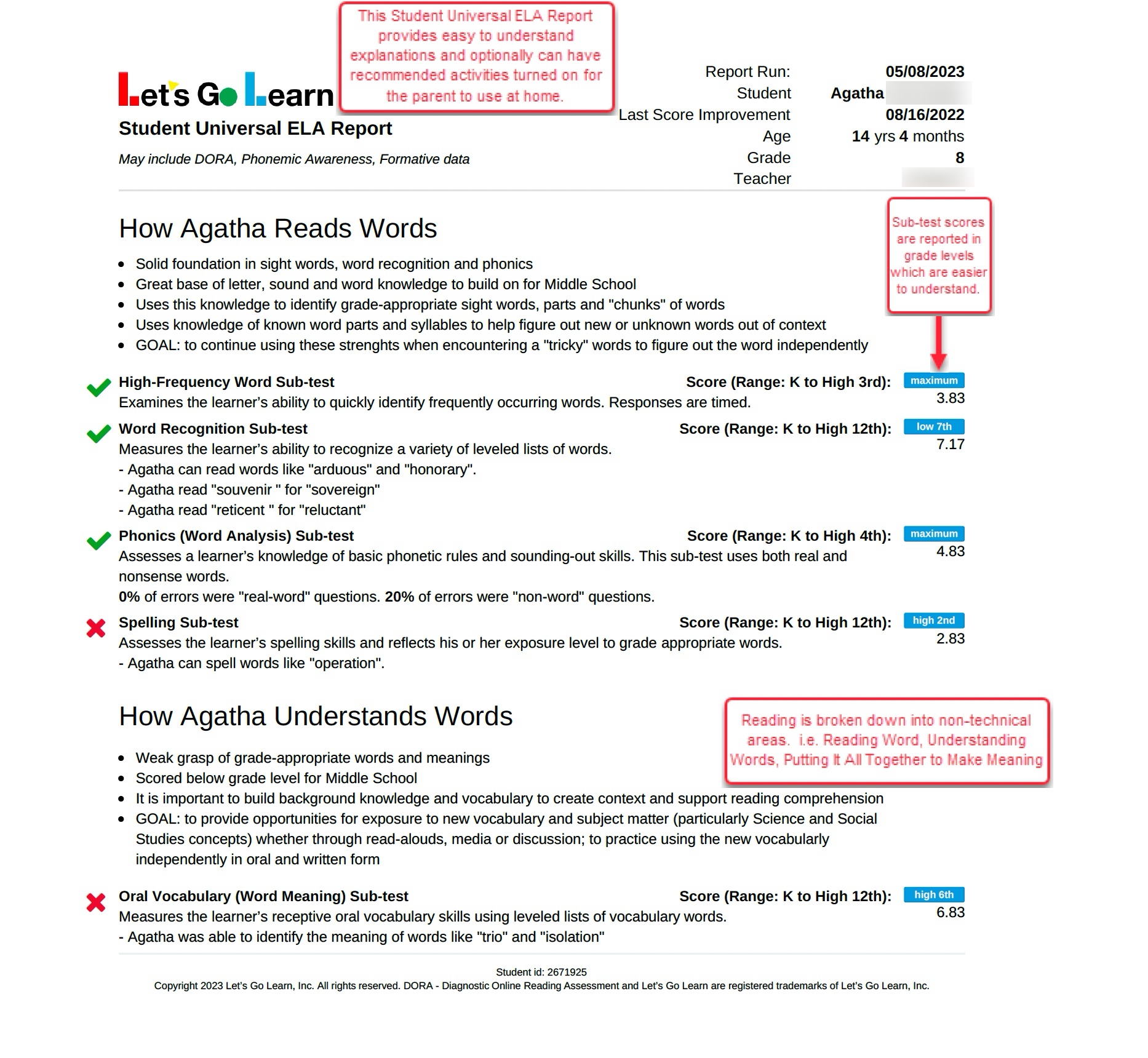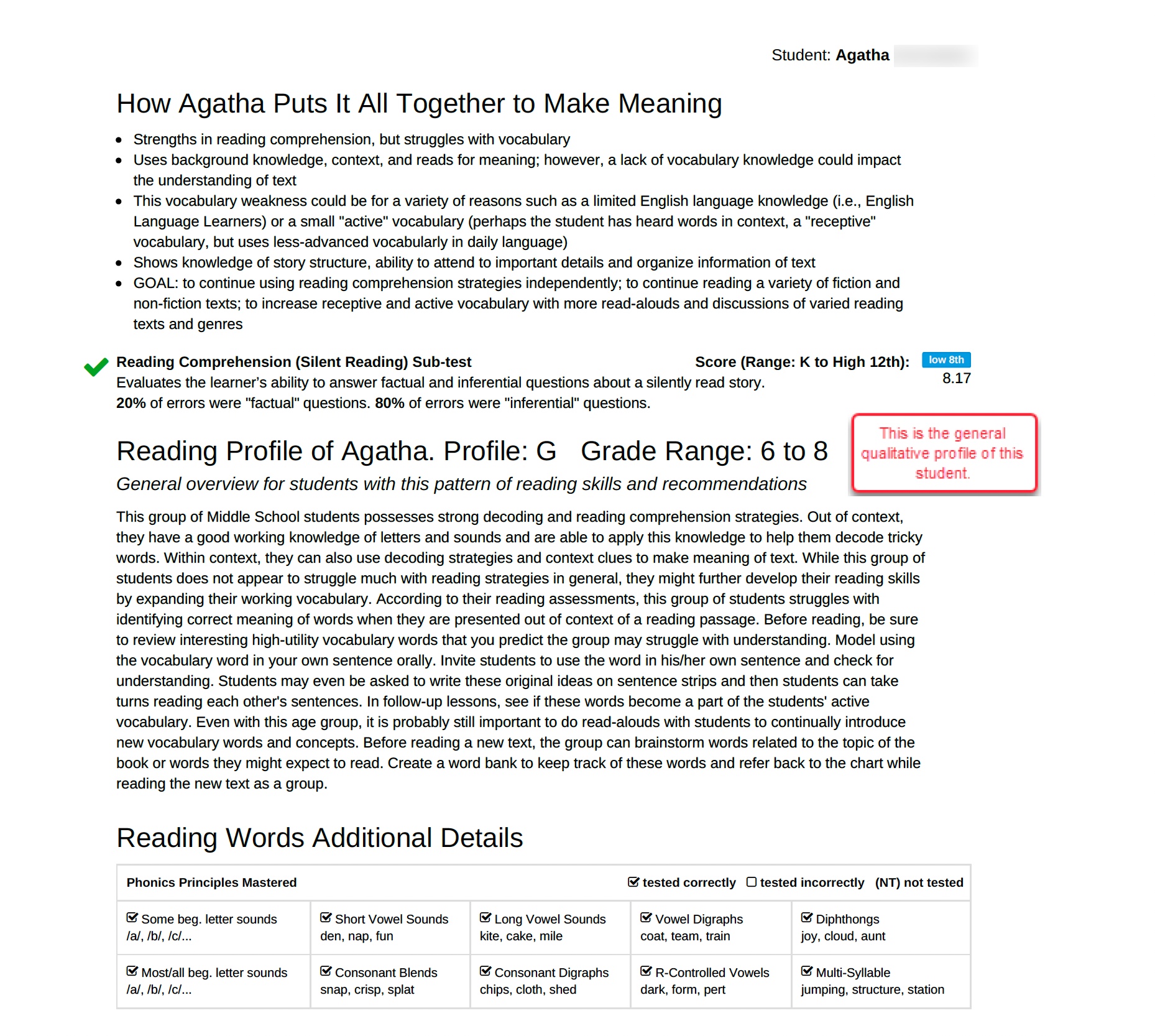DORA Summary Report

DORA Teacher/Parent Report


DORA SUB-TEST SUMMARIES
High-Frequency Word Sub-Test
Score Range: 0.50 to 3.83 (Mid-K to High 3rd)
This sub-test examines the learner's recognition of a basic sight word vocabulary. Sight words are every-day words that a reader sees when reading, often called words of "most-frequent-occurrence." Many of these words are phonetically irregular (words that cannot be sounded out) and must be memorized. High frequency words like the, who, what and those make up an enormous percentage of the material for beginning readers. In this subtest, a learner will hear a word and then see four words of similar spelling. The learner will click on the correct word. This test extends through third-grade difficulty, allowing a measurement of fundamental high-frequency word recognition skills.
This is the only timed sub-test! Delayed responses will be recorded as incorrect. So, remind the student to go quickly. We do tell them this in our instructions.
0.17 = low grade; 0.5 = mid-grade; 0.83 = high grade
Word Recognition Sub-Test
Score Range: 0.50 to 12.83 (Mid-K to High 12th)
This sub-test tests the learner's ability to recognize a variety of phonetically regular (words that can be sounded out) and phonetically irregular words (words that cannot be sounded out). This test consists of words from the first-grade to the twelfth-grade difficulty. These are the words that readers become familiar with as they progress through school. This test is made up of words that may not occur as frequently as high frequency words but do appear on a regular basis. Words like tree and dog appear on lower-level lists and words like different and special appear on higher-level lists. In this sub-test, a learner will hear a word and see four text choices. The learner will try to click on the correct word.
0.17 = low grade; 0.5 = mid-grade; 0.83 = high grade
Phonics Sub-Test (Word Analysis)
Score Range: 0 to 4.83 (Low-K to High 4th)
This subtest is made up of questions testing the learner's ability to recognize parts of words and sound out words. The skills range from the most rudimentary - consonant sounds, to the most complex - pattern recognition of multi-syllabic words. This test examines strategies that align with kindergarten- through fourth-grade levels. Unlike the previous two tests, this sub-test focuses on the details of sounding out a word. Non-real words are used to reduce the possibility that the learner may already have committed certain words to memory. This sub-test will create a measurement of the learner's ability to sound out phonetically regular words. In this sub-test, a learner will hear a word and then see four words of similar spelling. The learner will click on the correct word.
|
Phonics Principle Mastery
|
Scoring Rubric
|
|
multi-syllable
|
4.83
|
|
diphthongs (most)
|
4.5
|
|
diphthongs (some)
|
4.17
|
|
r-controlled vowels
|
3.83
|
|
vowel diagraphs (most)
|
3.5
|
|
vowel diagraphs (some)
|
3.17
|
|
consonant diagraphs
|
2.83
|
|
long vowel (most)
|
2.5
|
|
long vowel (some)
|
2.17
|
|
consonant blends
|
1.83
|
|
short vowel (most)
|
1.5
|
|
short vowel (some)
|
1.17
|
|
beginning consonant (most)
|
0.50
|
|
beginning consonant (some)
|
0.17
|
|
no significant beginning sound mastery
|
0
|
Example: If a student received a phonics score of 2.5, this would mean they have mastered long vowels and instructionally is working on mastering consonant diagraphs.
The decimal part of any phonics scores indicates level of grade mastery within a particular grade. 0.17 = low grade; 0.5 = mid-grade; 0.83 = high grade.
Phonemic Awareness (PA) - Score as a percentage
This subtest is made up of purely of audio questions and answers which test the learner's ability to recognize and manipulate sounds within words. The score is based on the percent correct out of a total of 9 questions. This measure because of the number of items is only a screening for phonemic awareness.
Grades 2 and above:
0-43% = Probable weakness in PA
44-65% = Partial mastery in PA
66+% = Probable effective PA skills
Grades PreK to 1:
0-22% = Probable weakness in PA
23-55% = Partial mastery in PA
56+% = Probable effective PA skills
Note: If a PA score does not exist, the student may not have been tested in this category because diagnosis on other sub-tests told us the student didn't need phonemic awareness. All students grade 2 or lower take this sub-test.
Spelling Sub-Test
Score Range: 0.5 to 12.83 (Mid-K to High 12th)
This sub-test will assess the learner's spelling skills. Unlike some traditional spelling assessments, this subtest will not be multiple-choice. It will consist of words graded from levels one through twelve. The learner will type the letters on the web page and their mistakes will be tracked. This will give a measure of correct spellings.
If a student has a non-mastery on the lowest set of both High-frequency words and Word Recognition, the adaptive logic of DORA will turn the spelling sub-test off and a score of NT or 0 will appear.
0.17 = low grade; 0.5 = mid-grade; 0.83 = high grade
Word Meaning Sub-Test (Oral Vocabulary)
Score Range: 0.50 to 12.83 (Mid-K to High 12th)
This sub-test is designed to test the learner's receptive oral vocabulary skills. Unlike expressive oral vocabulary (the ability to use words when speaking or writing), receptive oral vocabulary is the ability to understand words that are presented orally. In this test of receptive oral vocabulary, the learners will be presented with four pictures, will hear a word spoken, and will then click on the picture that matches the word that they heard. For example, the learners may see a picture of an elephant, a deer, a unicorn and a ram. At the same time the learner will hear the word tusk, they should click on the picture of the elephant. All of the animals have some kind of horn but the picture of the elephant best matches the target word. This test extends to a twelfth-grade level. This skill is indispensable to the learner's ability to comprehend and read contextually, as successful contextual reading requires an adequate vocabulary.
0.17 = low grade; 0.5 = mid-grade; 0.83 = high grade
Silent Reading Sub-Test (Comprehension)
Score Range: 0.50 to 12.83 (Mid-K to High 12th)
This sub-test will evaluate the learner's ability to answer questions about a silently read story. Twelve graded passages with comprehension questions make up the range of this test. The comprehension questions will include a variety of factual and conceptual questions. For example, one question may ask, "Where did the boy sail the boat?" and the next question may ask "Why do you think the boy wanted to paint the boat red?" Students are exposed to passages based on their performance on earlier sub-tests. This sub-test adjusts to the student based on his or her performance in real-time. Therefore, the exact number of passages a student will read will vary.
Please note that our comprehension subtest tends to be viewed as "more difficult" out of many available comprehension assessments.
If a student has a non-mastery on the lowest set of both High-frequency words and Word Recognition, the adaptive logic of DORA will turn the comprehension sub-test off and a score of NT or 0 will appear.
0.17 = low grade; 0.5 = mid-grade; 0.83 = high grade
DORA Profile Groups.
Overview: DORA sub-tests can be sorted into three groups:
Decoding, Vocabulary, and Comprehension. Examining students based on whether they are below-grade OR at- or above-grade level yields eight possible categories. These categories will generally align to specific types of reading curriculum or interventions making them ideal for small group sorting or for school-wide curriculum planning.

Please see below under "Attachments" for how to interpret the DORA Summary and DORA Teacher/Parent reports.
Profile
Sign up now
Manage
Sign out



